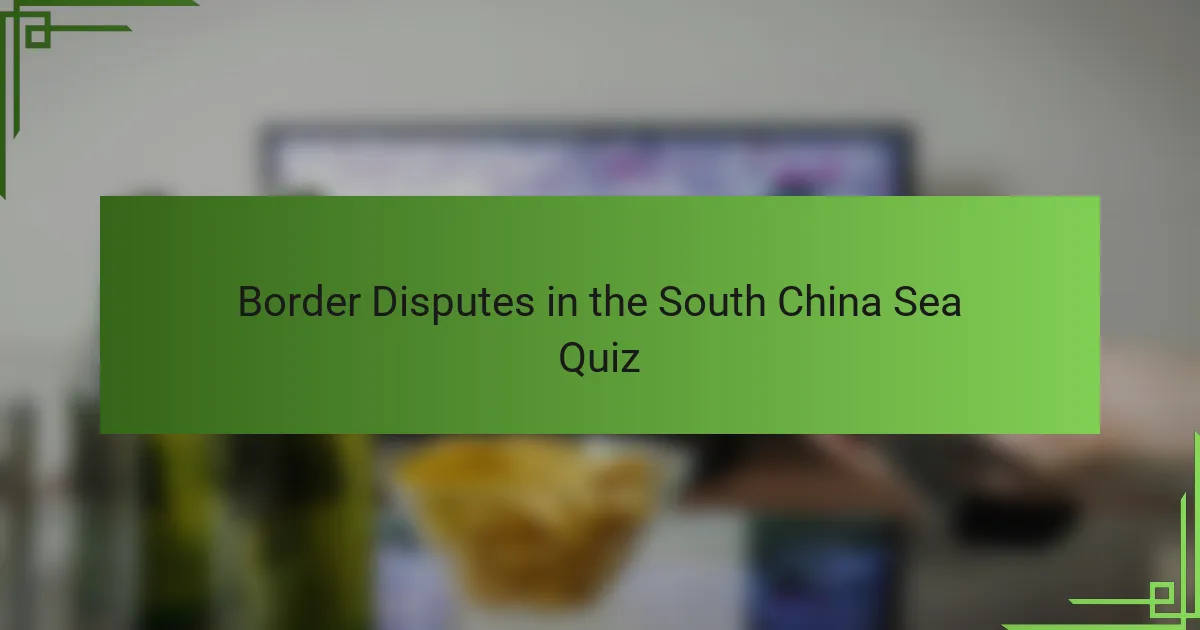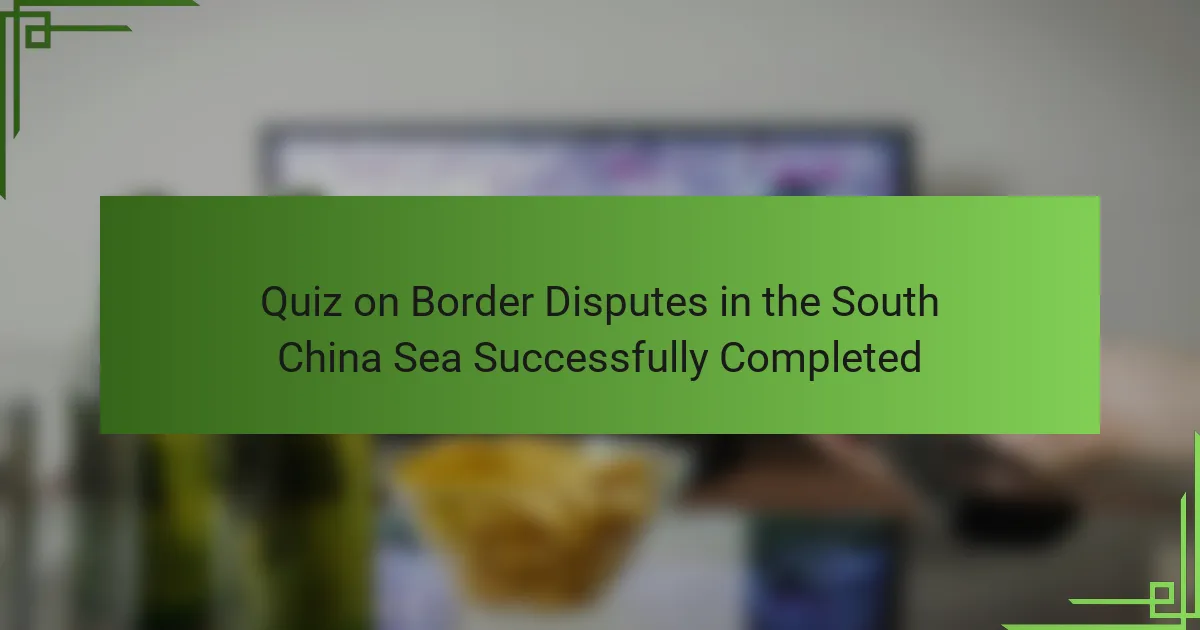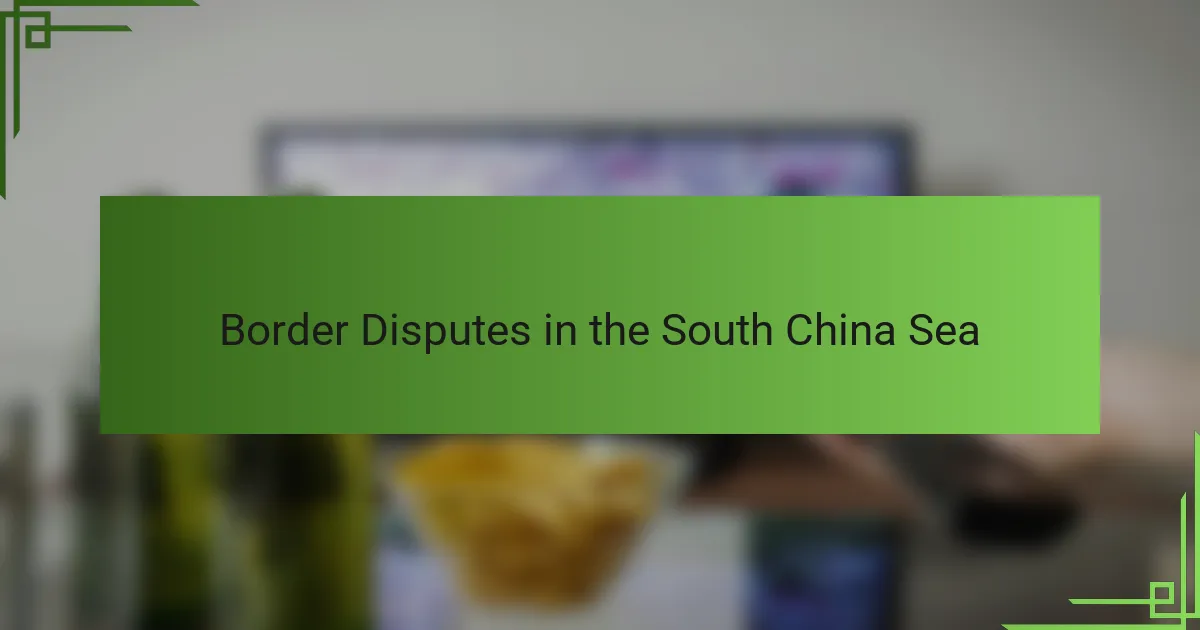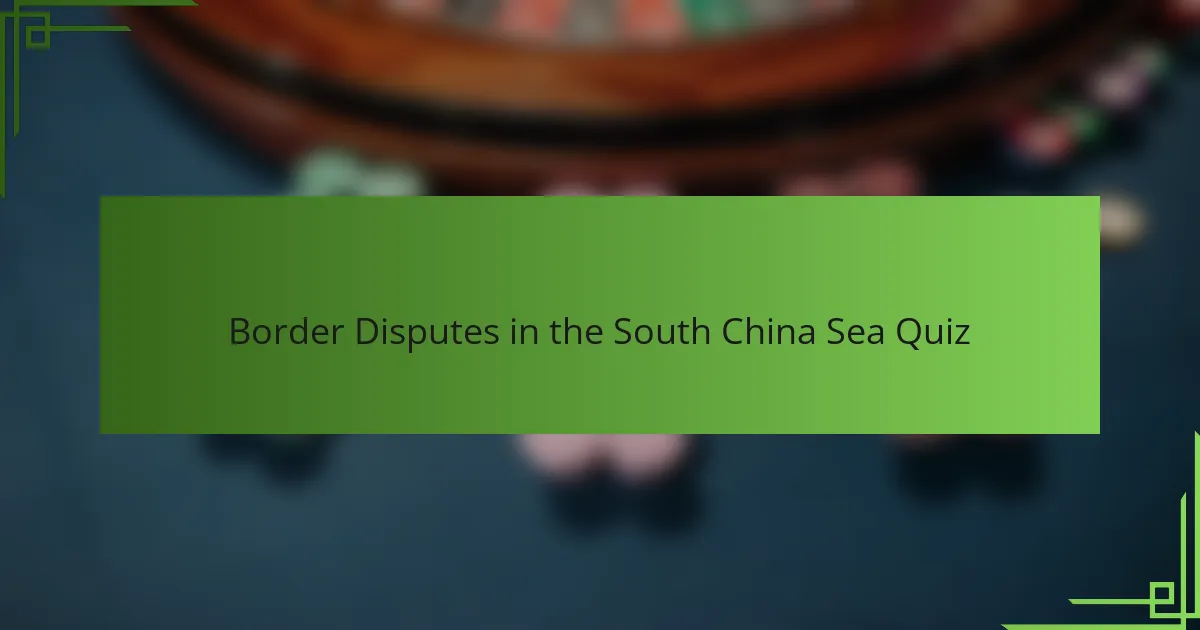
Border Disputes in the South China Sea Quiz
1. Which island group is central to multiple border disputes in the South China Sea?
- Paracel Islands
- Scarborough Shoal
- Natuna Islands
- Spratly Islands
2. What is the name of the line China uses to claim most of the South China Sea?
- Nine-Dash Line
- Eleven-Dash Line
- Eight-Dash Line
- Seven-Dash Line
3. Which country claims the Spratly Islands alongside China and several Southeast Asian nations?
- Malaysia
- Myanmar
- Indonesia
- Philippines
4. What is the main reef in the South China Sea contested by the Philippines and China?
- James Shoal
- Scarborough Shoal
- Spratly Islands
- Paracel Islands
5. Which strategic waterway in the South China Sea is crucial for global trade routes?
- Strait of Malacca
- Sunda Strait
- Bab el-Mandeb Strait
- Strait of Hormuz
6. What island claimed by Vietnam is also controlled by China in the South China Sea?
- Pratas Islands
- Spratly Islands
- Paracel Islands
- Scarborough Shoal
7. Which country built artificial islands that have escalated tensions in the South China Sea?
- Philippines
- Vietnam
- China
- Malaysia
8. What maritime feature is Scarborough Shoal primarily classified as?
- A volcanic island
- A submerged bank
- A coral atoll
- A continental shelf
9. Which ASEAN member countries are involved in territorial disputes in the South China Sea?
- Vietnam, Philippines, Malaysia, Brunei
- Malaysia, Singapore, Myanmar, Thailand
- Thailand, Cambodia, Laos, Myanmar
- Singapore, Indonesia, East Timor, Laos
10. Which historical maritime claim document did China present to assert its rights in the South China Sea?
- Nine-Dash Line
- Seven-Dash Line
- Ten-Dash Line
- Eleven-Dash Line
11. What tribunal ruled against China’s claims in the South China Sea in 2016?
- Permanent Court of Arbitration
- United Nations Tribunal on Sea Claims
- International Maritime Court
- International Court of Justice
12. Name the sea area located to the west of the Philippines involved in border disputes.
- Sulu Sea
- South China Sea
- Philippine Sea
- Celebes Sea
13. Which major global power has increased naval presence in the South China Sea to ensure freedom of navigation?
- India
- United States
- Russia
- Australia
14. What atoll is both Brunei and China interested in within the South China Sea region?
- Fiery Cross Reef
- Mischief Reef
- Louisa Reef
- James Shoal
15. Which disputed area in the South China Sea contains valuable oil and gas reserves?
- Scarborough Shoal
- Natuna Islands
- Spratly Islands
- Paracel Islands

Quiz on Border Disputes in the South China Sea Successfully Completed
Congratulations on completing the quiz on the border disputes in the South China Sea. This region is a complex and fascinating area of study in geography due to its strategic importance, rich natural resources, and overlapping territorial claims. Through the questions, you have explored key concepts such as maritime boundaries, international laws like UNCLOS, and the historical context behind the conflicts. Understanding these elements is essential to grasping the broader geopolitical challenges in this part of the world.
By participating in this quiz, you have gained insights into the diverse claims made by countries surrounding the South China Sea and the impact these disputes have on regional stability. You may have also learned about the various strategies used to assert territorial rights and the significance of the sea lanes for global trade. Such knowledge not only enhances your geographical awareness but also helps in appreciating how geography influences international relations and economic interests.
We encourage you to continue building your understanding by exploring the next section on this page. It offers detailed information on the South China Sea’s geographical features, the diverse nations involved, and ongoing diplomatic efforts to resolve disputes. Delving deeper into these topics will expand your expertise and provide a well-rounded perspective on this crucial area in geography. Keep learning and stay curious!

Border Disputes in the South China Sea
Geographical Overview of the South China Sea
The South China Sea is a marginal sea of the Western Pacific Ocean, encompassing an area of about 3.5 million square kilometers. It is surrounded by countries including China, the Philippines, Vietnam, Malaysia, Brunei, and Taiwan. The sea contains numerous islands, atolls, reefs, and shoals, many of which are strategically and economically significant. The Spratly Islands and Paracel Islands are among the most notable landforms. These features contribute to the sea’s complex maritime geography, which is critical for navigation, fishing, and potential natural resource exploitation.
Key Geographical Features Involved in Border Disputes
Several island groups and underwater features are central to the South China Sea border disputes. The Spratly Islands, consisting of over 100 small islands and reefs, are claimed in whole or part by China, Vietnam, the Philippines, Malaysia, and Brunei. The Paracel Islands, claimed by China, Vietnam, and Taiwan, are another vital cluster. The Scarborough Shoal, claimed by China and the Philippines, is strategically located near vital shipping lanes. These geographical features are essential for defining maritime boundaries and Exclusive Economic Zones (EEZs) under international law.
Geographical Basis of Territorial Claims by China
China’s territorial claims in the South China Sea are primarily based on the “Nine-Dash Line,” a demarcation that encloses most of the sea. This historic claim is based on Chinese maps dating back to the 1940s, asserting sovereignty over islands and waters within this boundary. Geographically, the line covers the Paracel and Spratly Islands and extends close to the coasts of other claimant states. China’s claims overlap significantly with those of other countries, generating intense geopolitical tensions linked to the control of landforms and maritime features.
Geopolitical Significance of the South China Sea’s Geography
The South China Sea’s geographical position is critical for international trade, with approximately one-third of global shipping passing through its waters. Its islands and reefs are potential sites for military bases, enhancing control over maritime routes. The geography also includes rich fishing grounds and possible oil and natural gas reserves beneath the seabed. These geographical factors increase the strategic value of the disputed territories to claimant states, intensifying the border disputes.
Impact of Physical Geography on Dispute Resolution Efforts
The dispersed nature of islands, reefs, and shoals in the South China Sea complicates clear boundary delimitation. Many features are submerged or only exposed at low tide, affecting their qualification as islands under the United Nations Convention on the Law of the Sea (UNCLOS). Physical geography influences the extent of maritime zones that states can claim, challenging dispute resolution. Engineering activities like land reclamation by China have altered the geographical landscape, further complicating negotiations and international legal assessments.
What are the main areas involved in the border disputes in the South China Sea?
The main areas involved in the border disputes in the South China Sea include the Spratly Islands, Paracel Islands, Scarborough Shoal, and various maritime zones surrounding these features. These regions are strategically important and rich in natural resources such as fisheries and potential oil and gas deposits. The disputes revolve around territorial sovereignty and maritime rights within these zones, claimed by multiple countries.
How are the territorial claims in the South China Sea determined?
Territorial claims in the South China Sea are determined based on international law, particularly the United Nations Convention on the Law of the Sea (UNCLOS), historical evidence, and effective control. Countries present historical maps, records of usage, and military or civilian presence to support their claims. However, disputes arise due to overlapping claims from countries such as China, the Philippines, Vietnam, Malaysia, Brunei, and Taiwan.
Where are the conflicting claimant countries located in relation to the South China Sea?
The conflicting claimant countries are located in Southeast Asia and East Asia around the South China Sea. China lies to the north, the Philippines to the northeast, Vietnam to the west, Malaysia and Brunei to the south, and Taiwan to the north. Their geographic proximity fuels contention over maritime boundaries and control of the sea and islands.
When did the South China Sea disputes intensify in recent history?
The South China Sea disputes intensified significantly since the late 20th century, particularly after the 1970s when offshore oil exploration began. Tensions escalated further after the 2010s, especially following China’s construction of artificial islands and military installations. A notable moment was in 2016 when the Permanent Court of Arbitration ruled against China’s claims in a case filed by the Philippines.
Who are the main countries involved in the South China Sea border disputes?
The main countries involved in the South China Sea border disputes are China, the Philippines, Vietnam, Malaysia, Brunei, and Taiwan. These countries assert overlapping claims over islands and maritime zones, seeking to control strategic waterways and access to natural resources. China claims the largest area based on its “Nine-Dash Line,” which overlaps with claims from the other countries.
